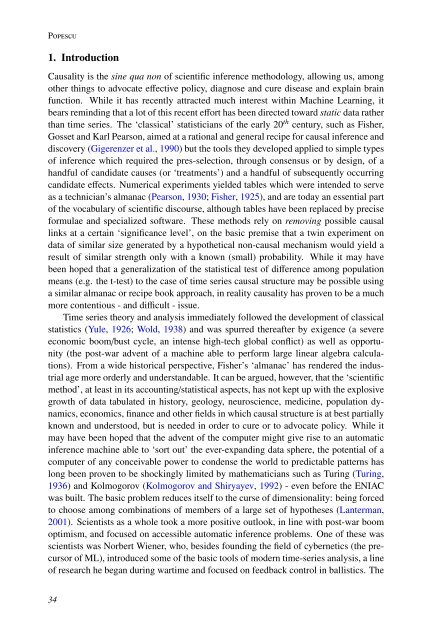Causality in Time Series - ClopiNet
Causality in Time Series - ClopiNet
Causality in Time Series - ClopiNet
Create successful ePaper yourself
Turn your PDF publications into a flip-book with our unique Google optimized e-Paper software.
Popescu1. Introduction<strong>Causality</strong> is the s<strong>in</strong>e qua non of scientific <strong>in</strong>ference methodology, allow<strong>in</strong>g us, amongother th<strong>in</strong>gs to advocate effective policy, diagnose and cure disease and expla<strong>in</strong> bra<strong>in</strong>function. While it has recently attracted much <strong>in</strong>terest with<strong>in</strong> Mach<strong>in</strong>e Learn<strong>in</strong>g, itbears rem<strong>in</strong>d<strong>in</strong>g that a lot of this recent effort has been directed toward static data ratherthan time series. The ‘classical’ statisticians of the early 20 th century, such as Fisher,Gosset and Karl Pearson, aimed at a rational and general recipe for causal <strong>in</strong>ference anddiscovery (Gigerenzer et al., 1990) but the tools they developed applied to simple typesof <strong>in</strong>ference which required the pres-selection, through consensus or by design, of ahandful of candidate causes (or ‘treatments’) and a handful of subsequently occurr<strong>in</strong>gcandidate effects. Numerical experiments yielded tables which were <strong>in</strong>tended to serveas a technician’s almanac (Pearson, 1930; Fisher, 1925), and are today an essential partof the vocabulary of scientific discourse, although tables have been replaced by preciseformulae and specialized software. These methods rely on remov<strong>in</strong>g possible causall<strong>in</strong>ks at a certa<strong>in</strong> ‘significance level’, on the basic premise that a tw<strong>in</strong> experiment ondata of similar size generated by a hypothetical non-causal mechanism would yield aresult of similar strength only with a known (small) probability. While it may havebeen hoped that a generalization of the statistical test of difference among populationmeans (e.g. the t-test) to the case of time series causal structure may be possible us<strong>in</strong>ga similar almanac or recipe book approach, <strong>in</strong> reality causality has proven to be a muchmore contentious - and difficult - issue.<strong>Time</strong> series theory and analysis immediately followed the development of classicalstatistics (Yule, 1926; Wold, 1938) and was spurred thereafter by exigence (a severeeconomic boom/bust cycle, an <strong>in</strong>tense high-tech global conflict) as well as opportunity(the post-war advent of a mach<strong>in</strong>e able to perform large l<strong>in</strong>ear algebra calculations).From a wide historical perspective, Fisher’s ‘almanac’ has rendered the <strong>in</strong>dustrialage more orderly and understandable. It can be argued, however, that the ‘scientificmethod’, at least <strong>in</strong> its account<strong>in</strong>g/statistical aspects, has not kept up with the explosivegrowth of data tabulated <strong>in</strong> history, geology, neuroscience, medic<strong>in</strong>e, population dynamics,economics, f<strong>in</strong>ance and other fields <strong>in</strong> which causal structure is at best partiallyknown and understood, but is needed <strong>in</strong> order to cure or to advocate policy. While itmay have been hoped that the advent of the computer might give rise to an automatic<strong>in</strong>ference mach<strong>in</strong>e able to ‘sort out’ the ever-expand<strong>in</strong>g data sphere, the potential of acomputer of any conceivable power to condense the world to predictable patterns haslong been proven to be shock<strong>in</strong>gly limited by mathematicians such as Tur<strong>in</strong>g (Tur<strong>in</strong>g,1936) and Kolmogorov (Kolmogorov and Shiryayev, 1992) - even before the ENIACwas built. The basic problem reduces itself to the curse of dimensionality: be<strong>in</strong>g forcedto choose among comb<strong>in</strong>ations of members of a large set of hypotheses (Lanterman,2001). Scientists as a whole took a more positive outlook, <strong>in</strong> l<strong>in</strong>e with post-war boomoptimism, and focused on accessible automatic <strong>in</strong>ference problems. One of these wasscientists was Norbert Wiener, who, besides found<strong>in</strong>g the field of cybernetics (the precursorof ML), <strong>in</strong>troduced some of the basic tools of modern time-series analysis, a l<strong>in</strong>eof research he began dur<strong>in</strong>g wartime and focused on feedback control <strong>in</strong> ballistics. The34





